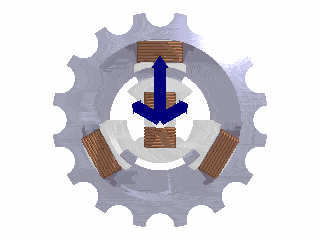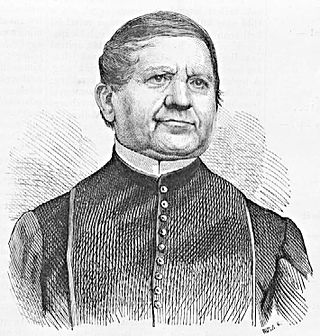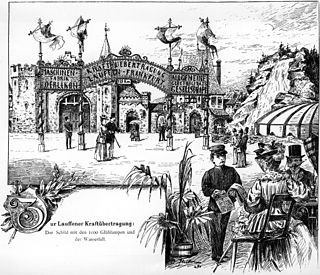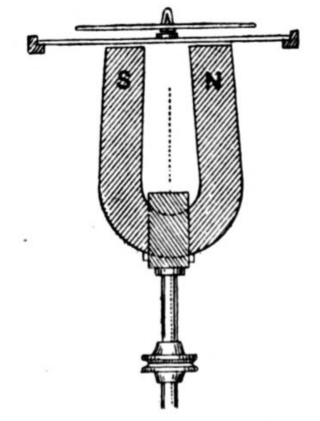Related Research Articles

Charles Proteus Steinmetz was an American mathematician and electrical engineer and professor at Union College. He fostered the development of alternating current that made possible the expansion of the electric power industry in the United States, formulating mathematical theories for engineers. He made ground-breaking discoveries in the understanding of hysteresis that enabled engineers to design better electromagnetic apparatus equipment, especially electric motors for use in industry.

George Westinghouse Jr. was an American entrepreneur and engineer based in Pennsylvania who created the railway air brake and was a pioneer of the electrical industry, receiving his first patent at the age of 19. Westinghouse saw the potential of using alternating current for electric power distribution in the early 1880s and put all his resources into developing and marketing it. This put Westinghouse's business in direct competition with Thomas Edison, who marketed direct current for electric power distribution. In 1911 Westinghouse received the American Institute of Electrical Engineers's (AIEE) Edison Medal "For meritorious achievement in connection with the development of the alternating current system." He founded the Westinghouse Electric Corporation in 1886.

An electric motor is an electrical machine that converts electrical energy into mechanical energy. Most electric motors operate through the interaction between the motor's magnetic field and electric current in a wire winding to generate force in the form of torque applied on the motor's shaft. An electric generator is mechanically identical to an electric motor, but operates in reverse, converting mechanical energy into electrical energy.

An alternator is an electrical generator that converts mechanical energy to electrical energy in the form of alternating current. For reasons of cost and simplicity, most alternators use a rotating magnetic field with a stationary armature. Occasionally, a linear alternator or a rotating armature with a stationary magnetic field is used. In principle, any AC electrical generator can be called an alternator, but usually the term refers to small rotating machines driven by automotive and other internal combustion engines.

An induction motor or asynchronous motor is an AC electric motor in which the electric current in the rotor that produces torque is obtained by electromagnetic induction from the magnetic field of the stator winding. An induction motor therefore needs no electrical connections to the rotor. An induction motor's rotor can be either wound type or squirrel-cage type.

A rotating magnetic field is the resultant magnetic field produced by a system of coils symmetrically placed and supplied with polyphase currents. A rotating magnetic field can be produced by a poly-phase current or by a single phase current provided that, in the latter case, two field windings are supplied and are so designed that the two resulting magnetic fields generated thereby are out of phase.

A polyphase system is a means of distributing alternating-current (AC) electrical power that utilizes more than one AC phase, which refers to the phase offset value between AC in multiple conducting wires; phases may also refer to the corresponding terminals and conductors, as in color codes. Polyphase systems have two or more energized electrical conductors carrying alternating currents with a defined phase between the voltage waves in each conductor; early systems used 4 wire two-phase with a 90° phase angle but for three-phase voltage, the phase angle is 120° or 2π/3 radians as Mikhail Dolivo-Dobrovolsky mathematically had shown this reduce the magnetic field fluctuation from 40% to a mere 15%. Polyphase systems are particularly useful for transmitting power to electric motors which rely on alternating current to rotate. The most common example is the three-phase power system used for industrial applications and for power transmission. Compared to a single-phase, two-wire system, a three-phase three-wire system transmits three times as much power for the same conductor size and voltage.

Power engineering, also called power systems engineering, is a subfield of electrical engineering that deals with the generation, transmission, distribution, and utilization of electric power, and the electrical apparatus connected to such systems. Although much of the field is concerned with the problems of three-phase AC power – the standard for large-scale power transmission and distribution across the modern world – a significant fraction of the field is concerned with the conversion between AC and DC power and the development of specialized power systems such as those used in aircraft or for electric railway networks. Power engineering draws the majority of its theoretical base from electrical engineering and mechanical engineering.

Silvanus Phillips Thompson was an English professor of physics at the City and Guilds Technical College in Finsbury, England. He was elected to the Royal Society in 1891 and was known for his work as an electrical engineer and as an author. Thompson's most enduring publication is his 1910 text Calculus Made Easy, which teaches the fundamentals of infinitesimal calculus, and is still in print. Thompson also wrote a popular physics text, Elementary Lessons in Electricity and Magnetism, as well as biographies of Lord Kelvin and Michael Faraday.

Galileo Ferraris was an Italian university professor, physicist and electrical engineer, one of the pioneers of AC power system and inventor of the induction motor although he never patented his work. Many newspapers touted that his work on the induction motor and power transmission systems were some of the greatest inventions of all ages. He published an extensive and complete monograph on the experimental results obtained with open-circuit transformers of the type designed by the power engineers Lucien Gaulard and John Dixon Gibbs.
This is an alphabetical list of articles pertaining specifically to electrical and electronics engineering. For a thematic list, please see List of electrical engineering topics. For a broad overview of engineering, see List of engineering topics. For biographies, see List of engineers.

Ányos István Jedlik was a Hungarian inventor, engineer, physicist, and Benedictine priest. He was also a member of the Hungarian Academy of Sciences, and author of several books. He is considered by Hungarians and Slovaks to be the unsung father of the dynamo and electric motor.

Edwin James Houston was an American author, electrical engineer, academic, businessman, and inventor.

An AC motor is an electric motor driven by an alternating current (AC). The AC motor commonly consists of two basic parts, an outside stator having coils supplied with alternating current to produce a rotating magnetic field, and an inside rotor attached to the output shaft producing a second rotating magnetic field. The rotor magnetic field may be produced by permanent magnets, reluctance saliency, or DC or AC electrical windings.

The history of electromagnetic theory begins with ancient measures to understand atmospheric electricity, in particular lightning. People then had little understanding of electricity, and were unable to explain the phenomena. Scientific understanding into the nature of electricity grew throughout the eighteenth and nineteenth centuries through the work of researchers such as Coulomb, Ampère, Faraday and Maxwell.

A dynamo is an electrical generator that creates direct current using a commutator. Dynamos were the first electrical generators capable of delivering power for industry, and the foundation upon which many other later electric-power conversion devices were based, including the electric motor, the alternating-current alternator, and the rotary converter.

The 1891 International Electrotechnical Exhibition was held between 16 May and 19 October on the disused site of the three former Westbahnhöfe in Frankfurt am Main, Germany. The exhibition featured the first long-distance transmission of high-power, three-phase electric current, which was generated 175 km away at Lauffen am Neckar. As a result of this successful field trial, three-phase current became established for electrical transmission networks throughout the world.

René Thury was a Swiss pioneer in electrical engineering. He was known for his work with high voltage direct current electricity transmission and was known in the professional world as the "King of DC."

Arago's rotations is an observable magnetic phenomenon that involves the interactions between a magnetized needle and a moving metal disk. The effect was discovered by François Arago in 1824. At the time of their discovery, Arago's rotations were surprising effects that were difficult to explain. In 1831, Michael Faraday introduced the theory of electromagnetic induction, which explained how the effects happen in detail.
Walter Bailys Polyphase motor (1879) marks the beginning of the development of modern polyphase motors. Mr. Bailey exhibited his invention on the Physical Society of London on June 28, 1879, on the occasion of his reading a paper entitled, "A Mode of Producing Arago's Rotations."
References
- ↑ Tom McInally, The Sixth Scottish University. The Scots Colleges Abroad: 1575 to 1799 (Brill, Leiden, 2012) p. 115
- ↑ OLEG D. JEFIMENKO, Electrostatic Motors, Their History, Types, and Principles of Operation, Electret Scientific Company - 1973, page 22-45
- 1 2 3 4 5 6 7 8 9 10 11 12 13 14 15 16 17 18 19 Doppelbauer, Martin (25 September 2014). "A short history of electric motors, 1800-1893". Karlsruhe Institute of Technology.
- 1 2 3 4 5 6 7 Drury, Bill (2001). Control Techniques Drives and Controls Handbook. Institution of Electrical Engineers. p. xiv. ISBN 978-0-85296-793-5.
- 1 2 3 4 5 6 7 8 9 10 11 12 Electropeadia. "Battery and Energy Technologies, Technology and Applications Timeline".
- 1 2 3 4 5 6 7 8 9 10 11 12 13 14 15 16 Multon, Bernard (June 1995). "Historique des Machines Électromagnétiques et Plus Particulièrement des Machines à Réluctance Variable" (PDF). Revue 3E (in French). I (3): 3–8. Archived from the original (PDF) on 2016-03-04. Retrieved 2013-03-06.
- 1 2 3 Martin, Thomas Commerford; Wetzler, Joseph (1891). The Electric Motor and Its Applications, with an Appendix on 'The Development of the Electric Motor Since 1888' by Louis Bell (3rd ed.). The W.J. Johnston Company, Limited. p. 315 pages.
- ↑ "Francois Arago". Encyclopædia Britannica. 22 February 2024.
- 1 2 3 4 5 Vučković, Vladan (November 2006). "Interpretation of a Discovery" (PDF). The Serbian Journal of Electrical Engineers. 3 (2). Retrieved 10 February 2013.
- ↑ Guillemin, Amédée (1891). 'Le Magnétisme et l'Électricitée' [Electricity and Magnetism]. trans., ed. & rev. from the French by Sylvanus P. Thompson. Macmillan and Co. Archived from the original on 2018-01-04.
- ↑ Heller, Augustus (April 1896). "Anianus Jedlik". Nature . 53 (1379). Norman Lockyer: 516–517. Bibcode:1896Natur..53..516H. doi: 10.1038/053516a0 .
- ↑ Blundel, Stephen J. (2012). Magnetism A Very Short Introduction. Oxford University Press. p. 36. ISBN 978-0-19-960120-2.
- ↑ Thein, M. "Elektrische Maschinen in Kraftfahrzeugen" [Electric Machines in Motor Vehicles](PDF) (in German). Archived from the original (PDF) on 14 September 2013. Retrieved 13 February 2013.
- ↑ "Elektrische Chronologie". Elektrisiermaschinen im 18. und 19. Jahrhundert – Ein kleines Lexikon ("Electrical machinery in the 18th and 19th centuries – a small thesaurus") (in German). University of Regensburg. 2004. Archived from the original on June 9, 2011. Retrieved August 23, 2010.
- ↑ "History of Batteries (inter alia)". Electropaedia. June 9, 2010. Archived from the original on May 12, 2011. Retrieved August 23, 2010.
- ↑ "Battery and Energy Technologies, Technology and Applications Timeline". Archived from the original on 2 March 2013. Retrieved 13 February 2013.
- ↑ "Institute - History - the invention of the electric motor 1800-1854". 25 September 2014.
- 1 2 3 4 5 6 7 8 9 Michalowicz, Joseph C. (Jan 1948). "Origin of the Electric Motor". Trans. AIEE. 67 (2): 1288–1292. doi:10.1109/T-AIEE.1948.5059817. S2CID 51648310.
- ↑ King, H. James (April 1833). "Paper 30: Development of Electrical Technology in the 19th Century: III" (PDF). American Journal of Science, 24: 146; Bulletin 228: Contributions from the Museum of History and Technology, p. 349. p. fig. 21 Pixii magneto generator, without commutator.
- 1 2 3 4 5 Boursin, Philippe. "Histoire de la Voiture Électrique". Archived from the original on 2013-09-26. Retrieved 2013-03-06.
- ↑ Kenyon College Physics Dept. "Froment motors".
- ↑ Thompson, Silvanus Phillips (1895). "4". Polyphase Electric Currents and Alternate-Current Motors. London: E. & F. N. SPON. p. 87.
- ↑ Baily, Walter (June 28, 1879). "A Mode of Producing Arago's Rotation". Philosophical Magazine. 3 (1). Taylor & Francis: 115. Bibcode:1879PPSL....3..115B. doi:10.1088/1478-7814/3/1/318.
- ↑ Thompson, Silvanus Phillips (1895). "4". Polyphase Electric Currents and Alternate-Current Motors. London: E. & F. N. SPON. p. 90.
- ↑ Thompson, Silvanus Phillips (1895). "4". Polyphase Electric Currents and Alternate-Current Motors. London: E. & F. N. SPON. p. 91.
- ↑ H. Hooshyar; M. Savaghebi; A. Vahedi: Synchronous generator - Past, present and future
- ↑ AC Power History and Timeline
- ↑ Thompson, Silvanus Phillips (1895). Polyphase Electric Currents and Alternate-Current Motors. London: E. & F. N. SPON. pp. 91–93.
- ↑ Sprague, Frank J. (May 1934). "Digging in the "Mines of the Motors"". Trans. AIEE. 53 (5): 695–706. doi:10.1109/T-AIEE.1934.5056690. S2CID 51648076.